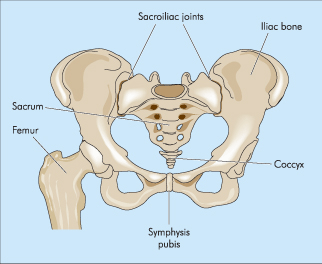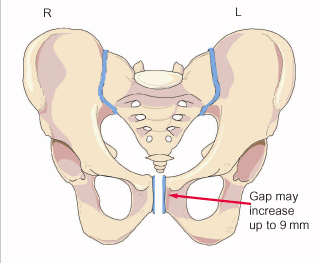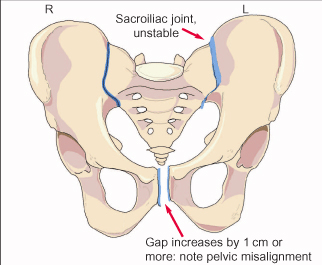Hip Pain
Chiropractic treatment is effective for hip pain. There are many reasons for having pain over the hip; one of the most common reasons is referred pain from…
Chiropractors are able to treat various causes of pelvic pain in pregnancy, including symphysis pubis dysfunction (SPD) and diastasis symphysis pubis (DSP).
Chiropractic treatment is a safe and natural approach that does not rely on painkillers or non-steroidal anti-inflammatory medication (NSAIDs) during pregnancy. SPD can greatly impact the quality of life for some women, affecting their relationships, employment, and daily activities. Early chiropractic treatment can help reduce the risk of becoming a chronic sufferer and improve mobility.

Want to know more? Request a Callback
Or give us a call, to find out how we can help you with Pelvic Pain, Dysfunction and Chiropractic Treatment.
Book an Appointment
Schedule an appointment for Pelvic Pain, Dysfunction and Chiropractic Treatment tailored to your needs.
Pelvic dysfunction, first described in 1870, can be severely disabling and limit a person’s quality of life. The condition consists of a relaxation of the pelvic articulations, which can hinder locomotion and cause distressing sensations.
Early chiropractic treatment is essential to reduce the risk of becoming a chronic sufferer. While not life-threatening, pelvic dysfunction can have a significant impact on a person’s daily activities and mobility.
The pregnancy hormone ‘relaxin’ softens and ‘relaxes’ the ligaments of the body in order to allow the pelvis to open slightly during labour. This is to help the baby move more easily through the pelvic canal. The levels of the hormone relaxin peak at around 12 weeks of pregnancy and therefore it is not uncommon for symptoms of pelvic dysfunction to occur around this time.
However, not all women suffer from pelvic pain during pregnancy, some only suffer post-natally, after giving birth. Some women will experience pelvic pain in their first pregnancy and not subsequently, while others will suffer from this distressing problem with each and every baby.
There are two conditions under the general term of Pelvic Dysfunction: Symphysis Pubis Dysfunction and Diastasis Symphysis Pubis. The symptoms are the same, so what is the difference?

This simply means that the joint at the front of the pelvis (the symphysis pubis) is not working as it should be. Together with the two large joints at the back of the pelvis (the sacroiliac, or SI joints), the symphysis pubis plays an important part in holding the pelvis steady during any activity, which involves the legs. If the joint is not firmly ‘tied’ by its ligaments it cannot perform its role effectively, resulting in excessive strain being placed on all the pelvic joints. This can give rise to the symptoms of SPD.
It is important to remember that as the hormones of pregnancy equally affect the sacroiliac joints, they too become slightly looser. It is, therefore, common for the problem to lie with one or both of the sacroiliac joints, with this putting extra stress on the symphysis pubis. In other words, the term SPD is flagging up the fact that the pelvic girdle is not functioning correctly, and unless an abnormal gap is definitely shown at the symphysis pubis (see diastasis symphysis pubis), the condition will be termed SPD.
The ‘Normal Gap’
The normal non-pregnant gap at the symphysis pubis (the distance between the two sides of the joint) is 4-5mm but in every pregnancy, there will be an increase in this gap of at least 2-3mm. This is due to the fact that the ligaments that ‘tie’ the joint together become slacker under the influence of the pregnancy hormones. Therefore, it is considered that a total width of up to 9mm between the two bones is normal for a pregnant woman.

Following delivery, this natural extra gapping decreases within days although the supporting ligaments will take 3 to 5 months to fully return to their normal state to make the symphysis pubis a strong joint again.
DSP means an abnormally wide gap is present between the two pubic bones at the symphysis pubis, diagnosed conclusively by investigation such as x-ray (post-partum), ultrasound or an MRI scan (magnetic resonance imaging).
An abnormal gap is considered to be 10mm or more, sometimes with the two bones being slightly out of alignment. This abnormal gap remains evident after the time that the joint should have regained the normal non-pregnant width.

The most popular view is that SPD occurs simply as a result of the pregnancy hormones, causing a laxity of the pelvic ligaments, which then no longer hold the joint steady with movements of the legs.
It is sometimes thought that women whose joints are more flexible before pregnancy may be more susceptible to the effect of hormones during pregnancy. Another theory is that the cause of SPD is hormonal in conjunction with biomechanical – the fact that the pelvic girdle has to carry an expanding uterus and growing foetus. Some also believe that SPD is primarily a problem of misalignment of the pelvis, leading to extra pressure on the cartilage of the symphysis pubis, and leading to the belief that the first line of treatment of SPD should be to address the possibility of pelvic misalignment.
Other Risk factors
Other risk factors of developing SPD include:
These vary with the severity of the condition and symptoms will be experienced differently for every woman. It has been found that the severity of the symptoms does not relate to the degree of separation at the symphysis pubis joint and therefore, in the presence of pain, a separation between 5 and 9mm is diagnostic.
The pain may remain static, i.e. in just one place such as the front of the pelvis or in other cases it may start in one area and move to other areas. It is likely that you will experience a combination of the symptoms. These include:
Because the pelvis serves as an anchoring point for many of our muscles and the pelvic joints play an important role in weight bearing activities, chiropractors often hear from their patients that they have a difficulty with: Rolling over in bed Going up or down stairs Getting in and out of cars Sitting down / getting up Putting on clothes Bending Lifting / standing on one foot Lifting heavy objects Getting moving, especially after sleep Getting in / out of the bath Difficulty walking with a long stride
The pain of symphysis pubis dysfunction often comes on early in pregnancy, even as early as 12 weeks, when the level of the hormone ‘relaxin’ increases.
The pain can develop slowly, gradually gaining in severity as the pregnancy progresses, owing to postural changes and the change in centre of gravity, the growing baby and the increasingly unstable pelvis.
In some cases the pain can come on suddenly, e.g. after a fall or sudden separation of the thighs (too wide too quickly).
Self-Help Information For Symphysis Pubis Dysfunction
It is important to ask for help and accept help at every opportunity. The key points to remember are:
Plan or think ahead about every task! Ask yourself: ‘How can I make it easier?’, ‘Do I have everything I need?’, ‘Do I really need to do that?’. After a while, you will not even be aware of the planning and things will become second nature.
Listen to your body – do not do too much of any one thing, i.e. Do not walk too far, do not sit for too long, do not exercise for too long – if it hurts, don’t do it! And remember, most people have no idea how you feel both physically and mentally. They can say and do things that might hurt or upset you without realising!
The chiropractor will take a thorough medical history and do a full chiropractic and orthopaedic examination to diagnose the condition.
Chiropractic treatment may involve:
The majority of women who receive chiropractic treatment for SPD, both before or after the baby is born, will experience a positive response particularly if the cause lies in pelvic misalignment. Chiropractic treatment aims to address the root cause of the problem instead of addressing only the symptoms. From the Chiropractic point of view, it is better for a woman with mild SPD to get treatment early on to prevent the problem from becoming more severe later or impeding the birth of your baby.